6 tips on which kitchen facades to choose: material and color
The average person spends in the kitchen up to 2 hours on weekdays and up to 3-4 hours on weekends. This room serves not only for cooking, but also for family gatherings after lunch and dinner. Often in the kitchen receive guests. Such multifunctionality imposes huge obligations on the kitchen interior. Of course, everything needs to be thought out, from decoration to small accessories. Particular attention is paid to elements that will catch the eye to the maximum. In the kitchen, these are furniture facades, because the set, as a rule, covers an entire wall, or even two adjacent ones. What facades for the kitchen is better to choose? Determine the material and color.
Basic requirements for a kitchen facade
The kitchen is a place with frequent changes in temperature and humidity, Water, dirt, and grease may fall on various surfaces. In addition, you often have to deal with hot dishes and brightly colored foods. All this forms special requirements for the material of the execution of the kitchen facade. Among the main we note:
- moisture resistance, including direct contact with water drops, as well as exposure to high humidity and steam;
- resistance to high temperaturessince the surface is near stove and oven they warm up decently, and contact with hot dishes is possible;
- easy care. Kitchen facades should be easy cleanse drops of grease and dirt, fingerprints, traces of dishes, food debris, etc .;
- resistance to mold and fungus. Ideally, the material itself should not rot, and also not allow the microflora to multiply;
- shock and scratch resistant allow the facade to retain its original appearance for a long time;
- resistance to natural dyes. Wine, coffee, various juices, blood from meat are easily absorbed into porous materials, and then it is difficult to remove them. Therefore, the facade material should not be porous;
- durability;
- aesthetics. The kitchen facade should not irritate and spoil the appetite. This is at least. Ideally, it should fit into the interior of the kitchen in style and color, meet the tastes and preferences of households.
There are many requirements, but there are a lot of materials that meet them. Facades made of wood, MDF and chipboard are actively used, metal options are considered more rare and exclusive.
 You can buy and order facades for the kitchen in Moscow from the manufacturer on the site of the MosMebel company. In production, Italian and German equipment is used, modern technologies are used. Kitchen facades are made of wood, MDF and plastic. The assortment of colors and textures is crazy.
You can buy and order facades for the kitchen in Moscow from the manufacturer on the site of the MosMebel company. In production, Italian and German equipment is used, modern technologies are used. Kitchen facades are made of wood, MDF and plastic. The assortment of colors and textures is crazy.
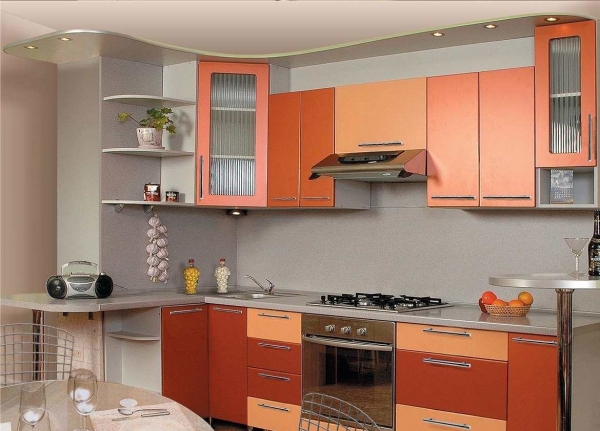
Wooden facade
Wood is a classic, tradition and elegance. Such facades fit perfectly into the classic and Scandinavian style, look good in country and provence. Wood gives the room a special warmth and comfort.
The advantages of wooden facades:
- environmental friendliness and the presence of a pleasant natural woody aroma;
- presentable appearance, solidity and elegance;
- durability;
- maintainability. If, over time, scratches, scuffs and other defects appear on the wood, they can be easily removed with the help of special equipment. It remains only to apply coat of varnish or paints - and the facade will be like new;
- the ability to quickly transform the look. With the help of varnish, paint or wood stain, wood can be given any shade and appearance. Aging techniques exist, and an inexpensive pine facade can be transformed so that it cannot be distinguished from a mahogany counterpart;
- solid wood is a dense homogeneous material, and therefore the fasteners in it hold well.

Minuses:
- high price. A facade made of natural wood is an expensive pleasure, because some manufacturers reduce the cost of technology a little. The sash frame is made of solid wood, and a panel of other material is inserted inside, including glass or MDF. By the way, veneered MDF is externally difficult to distinguish from wood. It turns out and save, and save woody aroma, and in terms of aesthetics do not suffer;
- in case of violation of the protective coating, moisture can enter the wood, causing the leaflets to swell, subsequent difficulties in opening them, creaks and mold. So the protective coating must be protected and updated as necessary;
- humidity, which in the kitchen varies widely, can affect the size of the facade. Possible fluctuations within 2-3 mm;
- wood suffers from rotting and darkening, but there are species that are more resistant to these phenomena than others. This, for example, larch, oak and beech;
- detergents must be selected carefully. It is not allowed to use abrasives, and some products may contain substances hazardous to wood.
There are also those who reproach the tree for insufficient diversity. If you take into account the unique shade of each breed, the wide possibilities of decoration (varnishing, staining, patination, etc.) and decoration (creating carvings and panels), it becomes obvious that the wooden facades are quite diverse.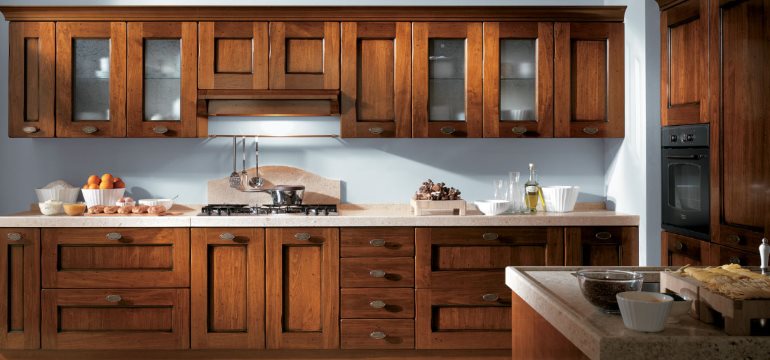
For the manufacture of a kitchen facade different types of wood:
- Pine - the most budget-friendly breed, it costs a little more than wood-based panels, it is highly soft, because even pets can scratch the material. Restoration will have to be carried out too often, and given that each damage is a risk of moisture getting inside the material, it is better to look in the direction of other species, and use the maximum pine to make the frame;
- ash much denser than pine, but also a couple of times more expensive. The wood has a light, slightly yellowish tint, looks great in Scandinavian interiorbut, if desired, it can be given a different shade;
- oak - strong expensive wood of saturated color, this is a real classic, although some may think that such a facade looks gloomy;
- beech reminds an oak in color, costs a little cheaper, perfectly shows itself in operation;
- larch It has an important advantage - resistance to moisture. This wood was used in the construction of the foundations of Venetian houses, for the construction of ships, and therefore it will withstand steam in the kitchen;
- cedar, cherry, mahogany, as well as exotic wood - These are less common materials. Such facades are expensive, but also look exclusive.
Wooden facades are heavy, because experts advise combining them with solid wood frames - glued boards may simply not withstand the load.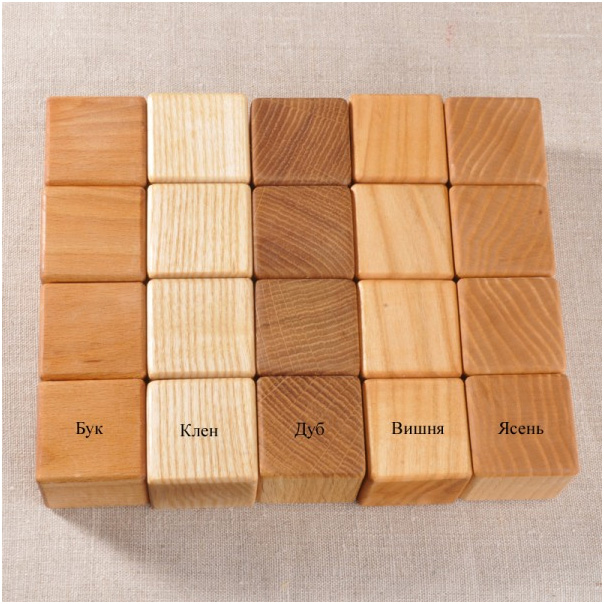
MDF kitchen facade
Most of the facades are made of MDF. This is a relatively inexpensive material that has acceptable durability and good performance. MDF is made from fine wood chips, which are pressed under the influence of high temperature and pressure. Urea resins are used as a binder, because formaldehyde emission in the finished board is low, at the level of natural wood. If we compare the slice of the MDF and chipboard, it is clear that MDF has a much higher density, which explains its operational characteristics.By itself, such a plate is nondescript, but thanks to numerous finishing methods, this drawback can be compensated.
Advantages of MDF kitchen facades:
- moisture resistance is higher than that of wood and chipboard;
- high strength, which allows the plate to easily cope with shocks and other mechanical stresses;
- MDF durability is lower than that of wood, but much higher than that of chipboard;
- resistance to temperature influences and humidity changes - what is needed for the kitchen;
- affordable cost, especially when compared with an analogue of wood;
- ease of processing, which allows you to create facades of various shapes;
- environmental friendliness;
- variety of finishes. MDF boards can be painted, veneered, covered with a film or plastic.
In cons lower durability can be attributed to wood, but the price of MDF is much lower.
Some of the performance of the facade is highly dependent on what material it is finished, so this point needs to be considered in detail.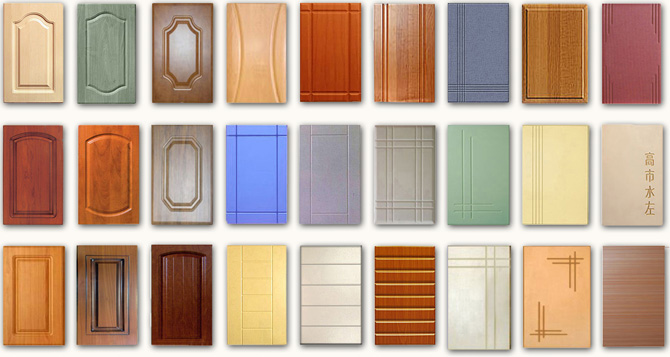
Painted MDF facade
The manufacturing technology involves the processing of the facade with a primer, after which several layers of enamel are applied to it, then a varnish layer is applied to the dried coating, the final stage is polishing.
Benefits:
- A wide selection of shades and textures. Color can be almost anything, and the surface itself - glossy, matte, pearl;
- the ability to make a facade of any shape;
- surface resistance to fading, mechanical stress and temperature fluctuations;
- simplicity in leaving - it is enough to wipe a surface with a soap solution. It is better not to use abrasive products so as not to leave scratches.
disadvantages:
- high cost, only veneered MDF is more expensive;
- fingerprints and other dirt are clearly visible on a glossy surface;
- with a strong impact, chips may appear, but small scratches can be easily restored;
- the need to wash only with soapy water.

Laminated MDF
A polyvinyl chloride film can be applied to MDF under a press. It does not look very good, but it comes out extremely budget.
Benefits:
- low price;
- a variety of films, so you can imitate any breed of wood, stone or leather. True, it is difficult to talk about such an imitation naturally;
- the film can be glued to facades of any shape;
- the film is not afraid of moisture, is easy to clean, and is quite resistant to abrasion.
Minuses:
- the film is afraid of high temperatures, especially their prolonged exposure, therefore it can begin to deform in places near the oven and stove;
- sensitivity to direct sunlight;
- low durability;
- caution when choosing detergents, as some aggressive substances can corrode the film or cause a color change.

Veneered MDF
Veneer is a thin section (up to 3 mm) of solid wood, which is obtained by sawing, planing or peeling the array. Almost all breeds are used. The veneer is glued onto MDF, can be additionally painted, then varnished. As a result, the facade looks as if made of solid wood, but at the same time it costs several times less.
Benefits:
- noble appearance of natural wood;
- a sufficient assortment, given the variety of species and methods of wood processing, as well as the ability to create facades with panels, radius facades;
- the ability to repair minor damage by grinding;
- relative durability.
disadvantages:
- maintenance of the facade will require observance of certain nuances, as well as with completely wooden facades;
- durability depends on the integrity of the paintwork; if necessary, it will have to be updated;
- the tree, alas, can lose color over time and succumb to moisture;
- the price is slightly higher than for MDF with other types of finishes (except for painted ones).

Finishing MDF with paper-laminate
Laminated paper (HPL) is made from multiple layers of paper that are impregnated with resinous materials and then pressed under the influence of high temperature and pressure. The resulting material is glued onto an MDF plate by postforming. The plastic is bent on both sides at the ends, the others are glued over with an edge, but another technology can be used when the ends are closed with aluminum or PVC.
Benefits:
- resistance to high temperatures, mechanical stress, high humidity;
- resistance to sunlight, over time, the appearance will not change, even if the kitchen is on the sunny side;
- durability.
disadvantages:
- surface easily collects fingerprints;
- abrasive detergents are not recommended, since minor scratches can reduce the reflectivity of the facade;
- inside the facades are usually made white;
- plastic odor may be present in the first days of use.

Acrylic finish MDF
Acrylic film has a thickness of not more than 2 mm and is a more advanced analogue of PVC film. With its help, they do not imitate the structure of wood - it is necessary to create bright facades with a glossy or pearl sheen. The main feature of acrylic is its high reflective properties.
Benefits:
- bright, modern appearance of facades with brilliance. If the kitchen is small, then the gloss will visually make it a little bigger;
- resistance to deformation and mechanical damage;
- resistance to high temperatures, moisture, direct sunlight;
- the ability to apply film to facades of complex shape.
disadvantages:
- only glossy texture;
- easily collects fingerprints;
- Do not use abrasive detergents, as well as products with aggressive chemicals in the composition.

MDF-based facade
Only a facade frame can be made of MDF, and the rest of the space will be filled with an insert of glass, plastic or rattan. The MDF frame itself can be veneered or glued with PVC film.
Benefits:
- a huge number of possible design options;
- low price;
- less weight compared to a facade made entirely of MDF, so the load on the fasteners will be lower.
disadvantages:
- difficulty in care. Not only can each material need its own care, but dirt will also accumulate in the joints;
- If the insert is not fastened securely, problems may occur during operation.

Particleboard kitchen facade
Particleboard is obtained from wood chips, which are pressed under the influence of special resins. If compared with MDF, then chipboard has a more loose structure. In addition, production features can lead to increased formaldehyde emissions during operation, therefore it is imperative that a safety certificate is required when purchasing. Of furniture, furniture frames are often made from chipboard, but in the most cost-effective kitchen sets, facades are also made from this material.
Benefits:
- low price;
- ample opportunities in terms of decor. Particleboard can, like MDF, glue with PVC film, trimmed with paper-laminate or veneer. The result is a decent-looking headset.

Minuses:
- low durability;
- Particleboard is afraid of water, because if the protective and decorative coating is damaged a little somewhere, the sash will begin to swell from exposure to water. For the same reason, all joints of the facade, places of contact with the wall and other hazardous areas are treated sealant;
- chipboard facades should not be hung above the slab at a height of less than 60 cm, otherwise they will quickly become worthless under the influence of steam;
- Due to the loose structure of the plate, the fasteners in it do not hold very well. During normal operation, you may not notice any inconvenience, but if you decide to make a small restoration, the hinges will have to be put in new places, since they won’t stay on the old ones.
Acceptable for operation in residential premises, the formaldehyde emission level is E1.
Metal facade
Metal facades are a rarity in ordinary home kitchens. This is an option for the kitchens of restaurants and cafes. But if the room is decorated in loft style or high tech, then such a headset may well fit in, and then you can enjoy all its many advantages.
Benefits:
- resistance to temperature extremes and fire;
- moisture resistance;
- hygiene and ease of care;
- resistance to mechanical stress;
- durability.

disadvantages:
- price;
- heavy weight;
- fingerprints easily remain on glossy metal;
- the metal kitchen facade does not fit into any interior.

Despite the fact that metal is rarely chosen as a material for the manufacture of facades, there are a variety of possible solutions:
- stainless steel facade can be called eternal, however, provided that the sheet thickness is from 4 mm;
- aluminum facade it will cost you less, it will weigh less, but this is a softer material, so saving on sheet thickness is definitely not worth it. Over time, scratches appear on aluminum, which are not always possible to get rid of;
- only frame can be aluminum, and an insert of tempered glass, plastic or MDF is mounted in it - practical, stylish and inexpensive.

Kitchen facade color
Let's be honest with ourselves. The first thing we appreciate when we see a particular headset model in a store or catalog is color. And only then we analyze the material of manufacture and other parameters. Fortunately, today you can buy furniture with a facade of any shade and design, however, personal preferences alone may not be enough - you must also consider the style of the kitchen, as well as the features of this room. Here are some tips to help you make the right choice:
- small kitchen and a facade of a dark or bright shade is a bad combination. In this case, it is better to give preference to light colors, and this can be either a plain or textured surface, for example, a wooden facade. A win-win option - a white facade;
- the facade is saturated with a deep shade - an excellent option for a spacious kitchen, where there is so lack of comfort;
- for kitchens with a lack of natural lighting, facades of warm shades: yellow, orange, pink colors of different saturations will be an excellent option. If the sun, on the contrary, is too much, but the balance can bring shades of blue, blue, green and purple;

- if convenience comes first in terms of cleaning, then pay attention to the brown facades - they are considered the least easily soiled;
- consider the features of the influence of color on the psyche. For instance, red excites the nervous system and causes appetite, green calming and blue gives a feeling of safety and reliability;
- consider room style and other kitchen items. For example, monophonic facades of the correct geometric shape with a minimum of decor (even handles may be absent) and metal inserts fit into minimalism and hi-tech. A combination of monochrome colors also looks good. Classic - These are facades made of wood or its imitation. Scandinavian style - these are white facades, smooth or wood-like. For provence a combination of wood and glass is characteristic, the presence of floral patterns, and for the loft, rough facade of a dark color is suitable;
- facades and furniture can be in harmony with each other, but can be completely different. Often with bright facades, furniture and accessories are used in neutral shades.

Finally, we note that when choosing a headset, you need to look not only at the facade material, but also at countertop material, because even more negative factors affect it.

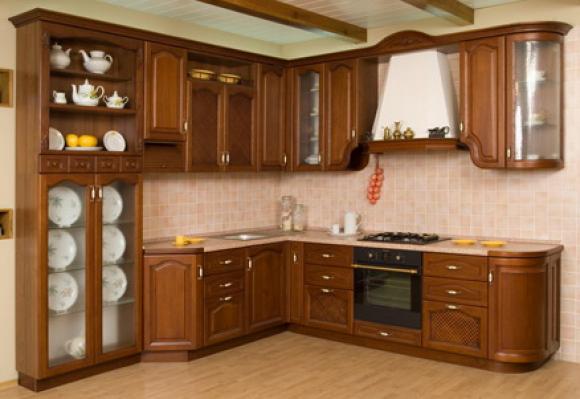
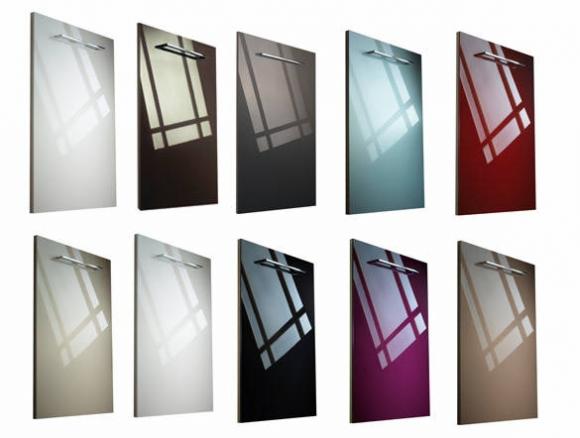
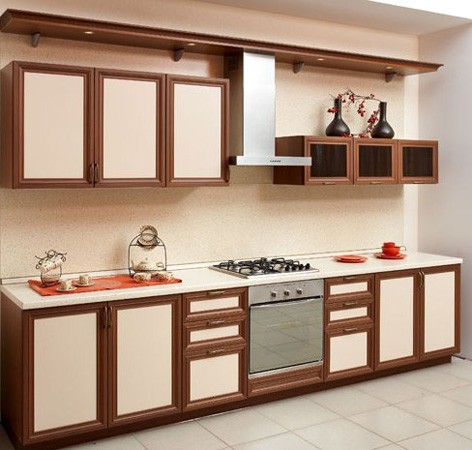

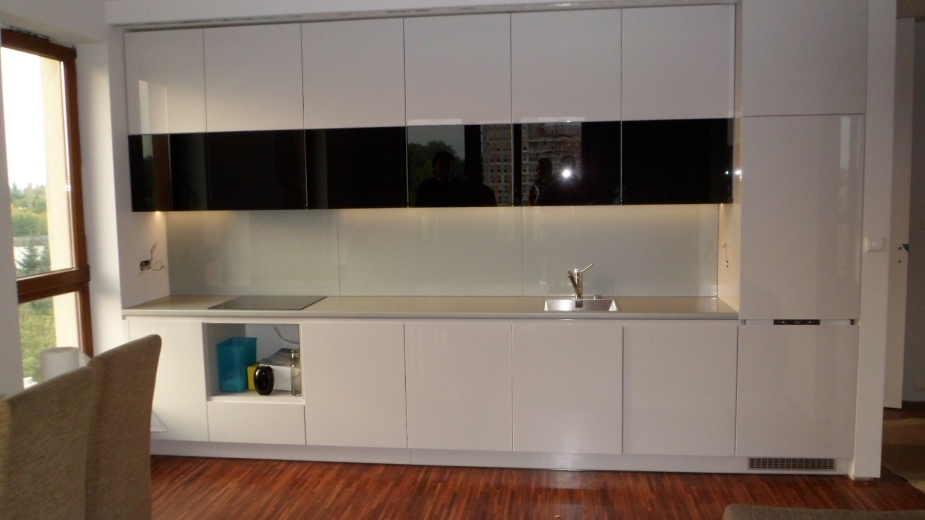


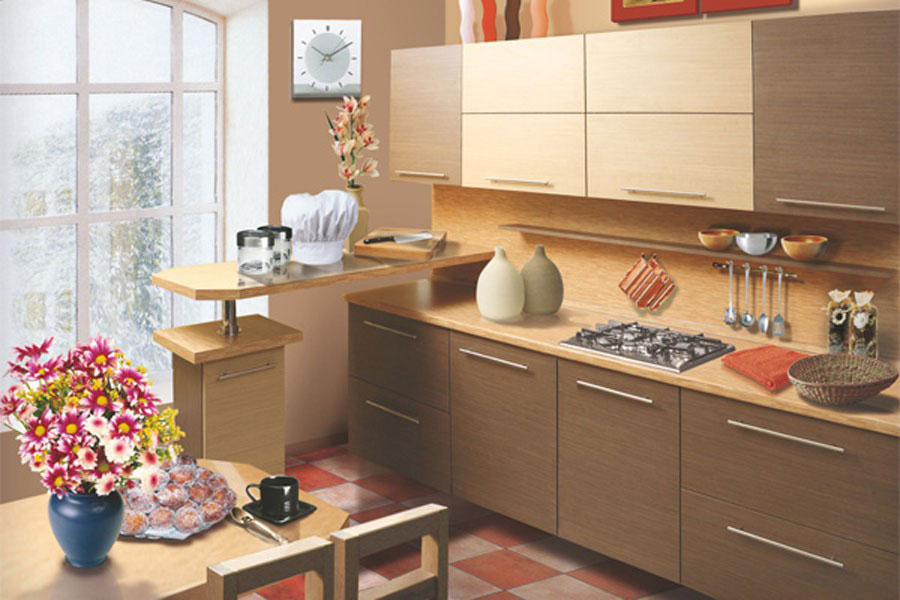
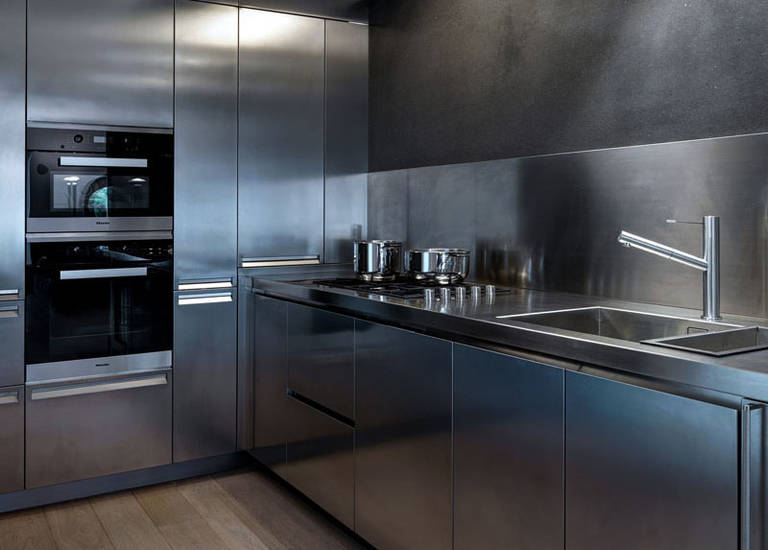
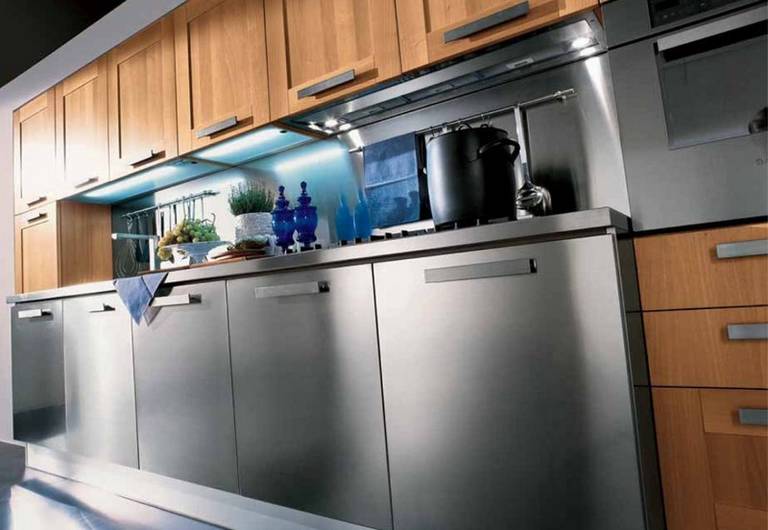
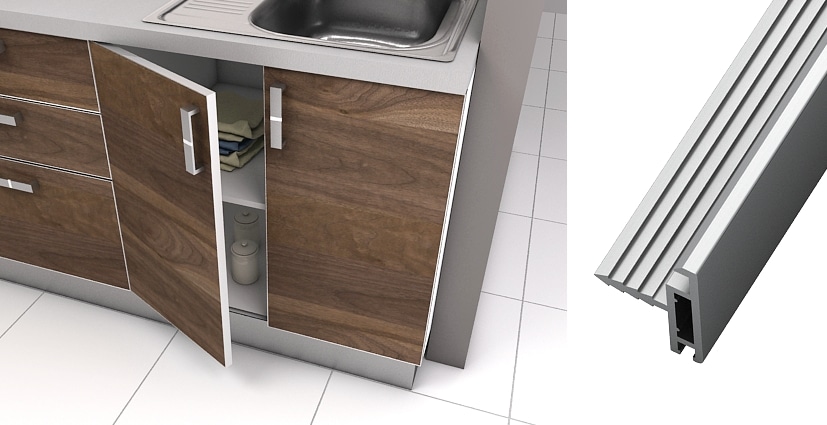

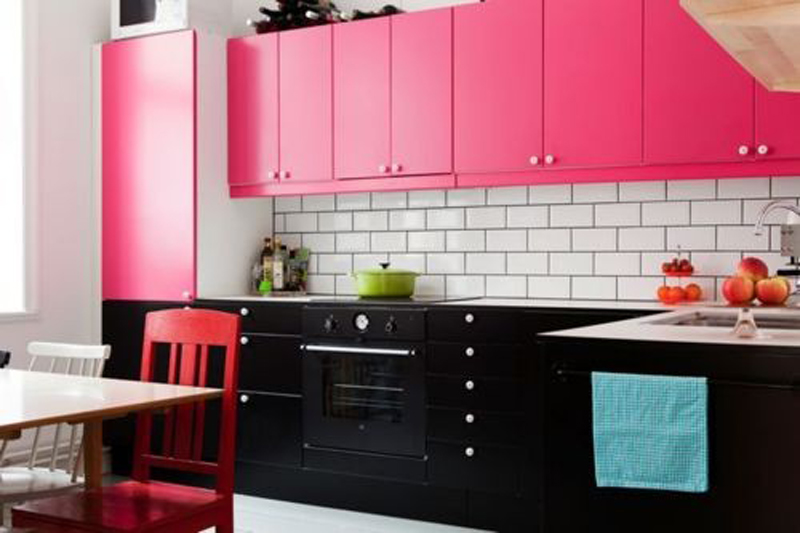
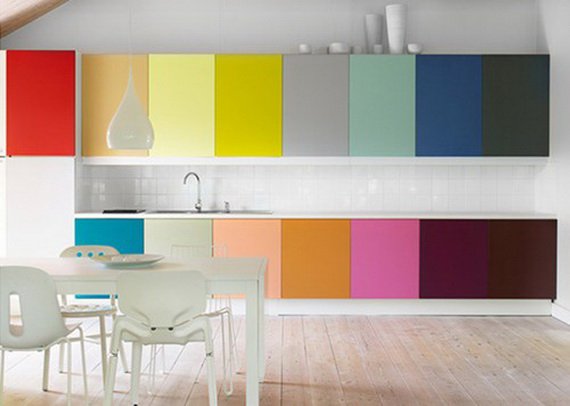
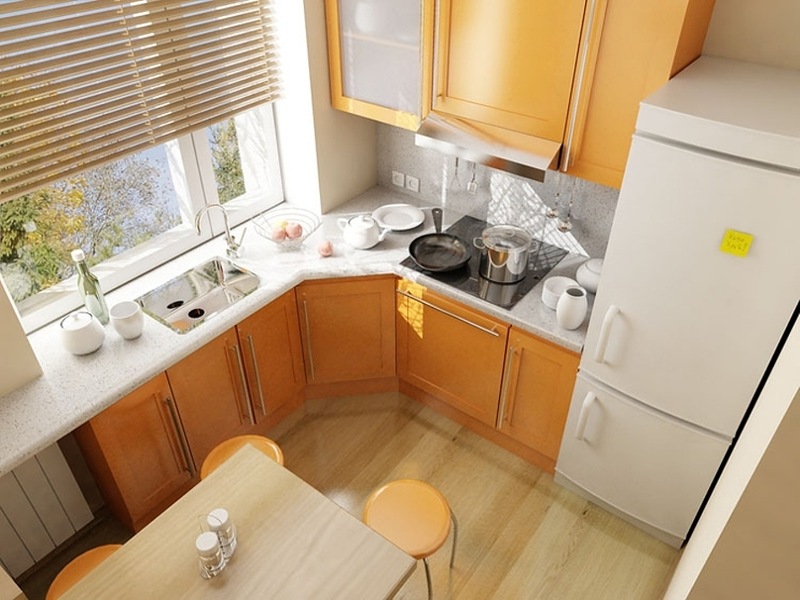
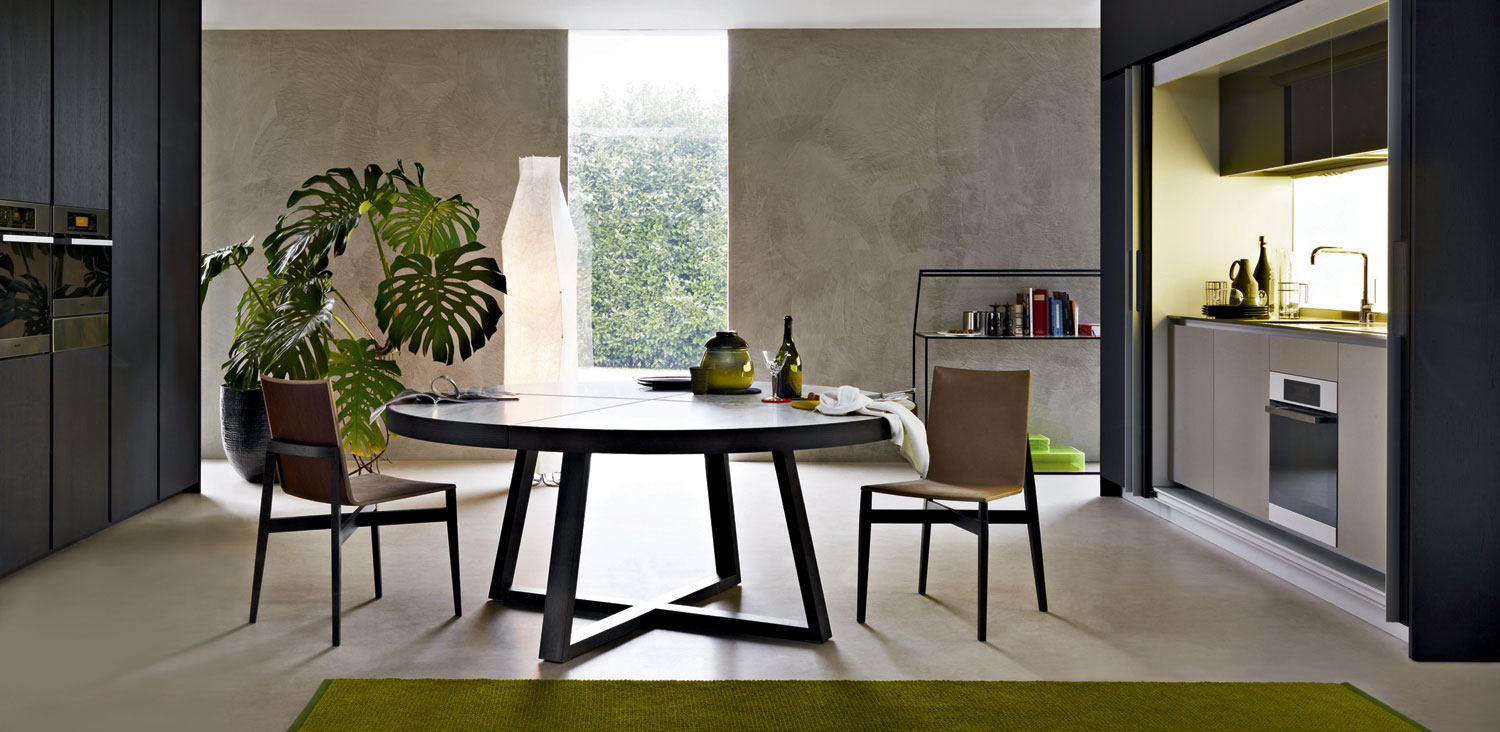
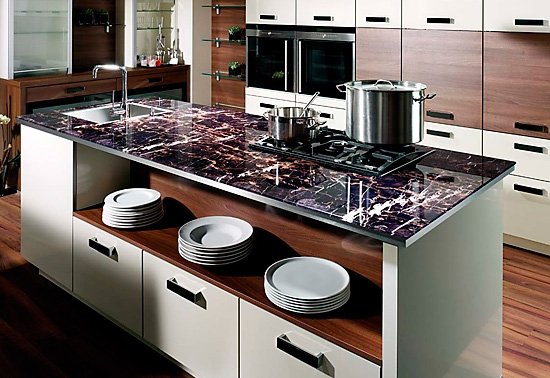
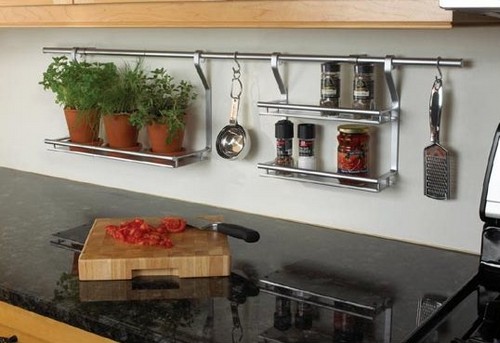
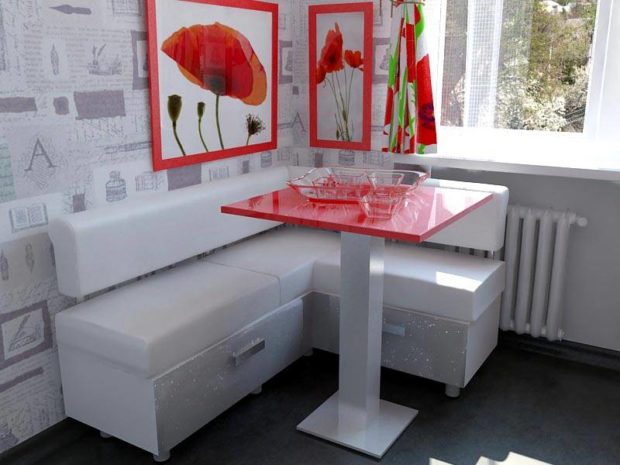

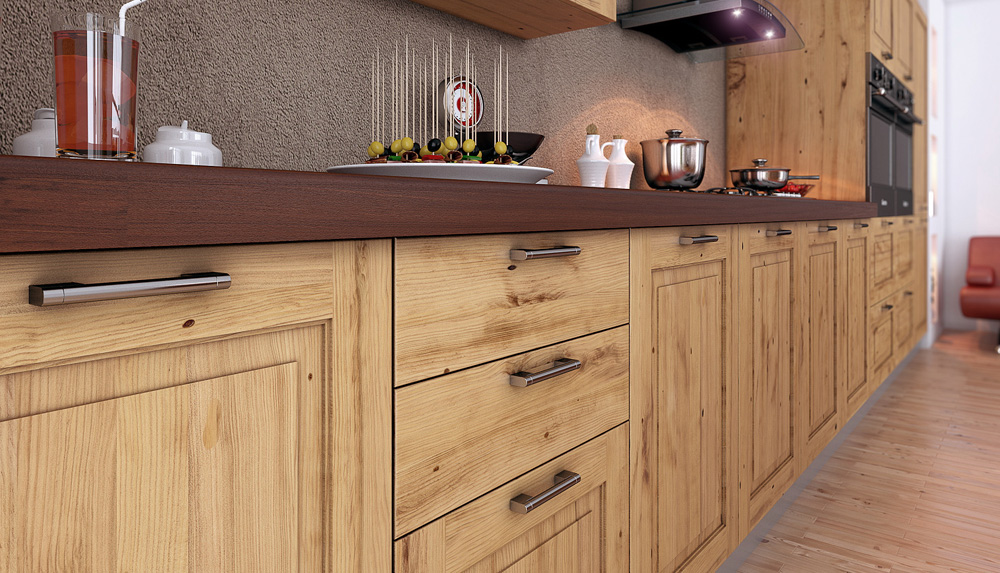
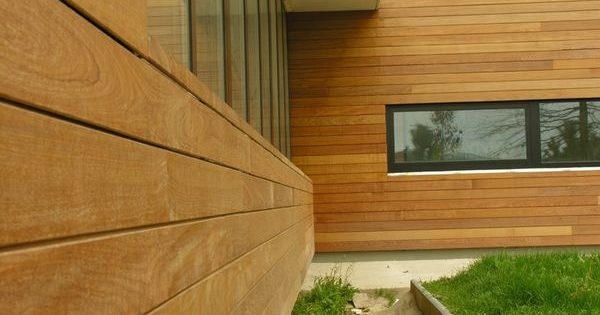
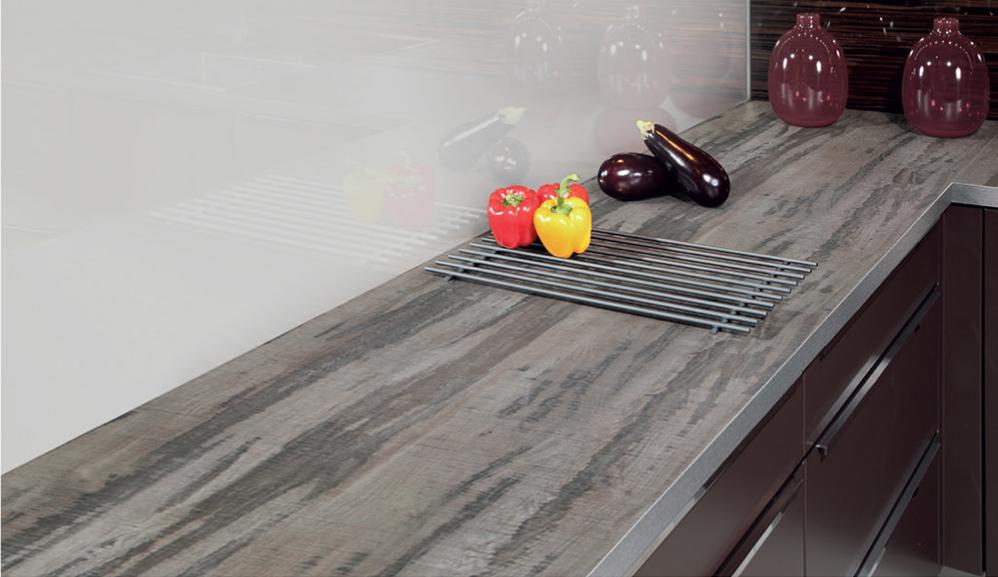
Thank you for the interesting information!
Modern models of kitchen sets are available for every taste and color.